Wearable HRV devices track the time between your heartbeats, giving insights into your stress levels, recovery, and overall health. Higher HRV indicates good balance, restful sleep, and resilience, while lower HRV can signal stress, fatigue, or lack of recovery. Factors like hydration, sleep quality, and stress influence your numbers. By understanding what each variation means, you can better optimize your wellbeing. Keep exploring to learn how to make the most of your HRV data.
Key Takeaways
- HRV numbers reflect your autonomic nervous system balance, indicating stress levels and recovery status.
- Higher HRV suggests better resilience, restful sleep, and effective stress management.
- Fluctuations in HRV can signal fatigue, overtraining, or health issues needing attention.
- External factors like hydration, stress, and sleep quality influence HRV readings.
- Consistent monitoring helps interpret trends, guiding lifestyle adjustments for improved wellness.
Understanding Heart Rate Variability and Its Significance
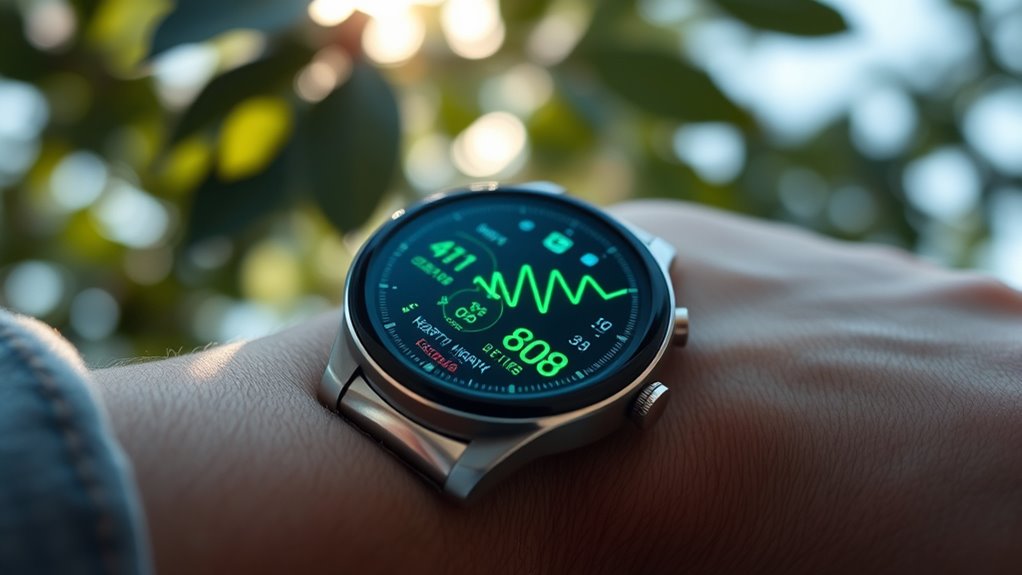
Understanding heart rate variability (HRV) is essential because it reflects how well your autonomic nervous system manages your heart’s rhythm. When your HRV is high, it indicates your body can adapt to stress and recover effectively, supporting better heart health. Conversely, low HRV may signal increased stress, fatigue, or health issues. HRV also influences sleep quality; higher variability often correlates with restful, restorative sleep, while lower HRV can lead to disrupted sleep patterns. Tracking your HRV gives you insight into your overall well-being, helping you identify lifestyle factors that impact your health. Additionally, autonomic nervous system plays a crucial role in regulating various bodily functions, including HRV. filtration technologies used in air purifiers can reduce airborne pollutants that may affect your respiratory health. Understanding the biological mechanisms behind HRV can deepen your awareness of how your body responds to different stressors and recovery processes. For example, maintaining consistent sleep schedules can positively influence your HRV, leading to improved health outcomes. By paying attention to these numbers, you can make informed choices to improve your heart health and sleep quality, promoting a healthier, more balanced life.
How Wearable Devices Measure HRV
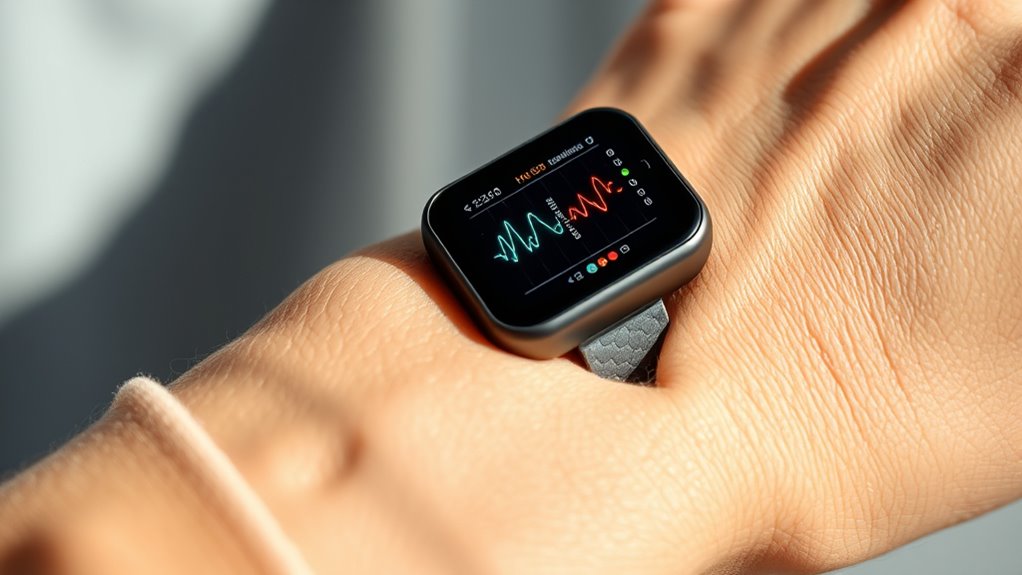
Wearable devices measure HRV primarily through sensors that monitor your heart’s electrical activity or blood flow. These sensors include electrocardiograms (ECG) and photoplethysmography (PPG). ECG sensors detect electrical signals directly from your heart, offering high sensor accuracy, while PPG sensors measure blood flow via light absorption, which is more convenient but slightly less precise. Here’s a visualization:
| Sensor Type | Method | Accuracy |
|---|---|---|
| ECG | Electrical signals from heart | Very high |
| PPG | Blood flow via light | Slightly lower |
| Data Privacy | Data security measures | Essential |
| User Impact | Comfort and convenience | Varies |
Your device processes these signals, but always consider data privacy and how securely your health data is stored and shared. Understanding HRV measurements can help you better interpret your health data and make informed lifestyle choices. Additionally, being aware of sensor accuracy can help you understand the reliability of your readings. Recognizing the data privacy implications associated with wearable health devices is also crucial for protecting your personal information. Furthermore, advancements in sensor technology continue to improve the precision of HRV readings, enhancing their usefulness for health monitoring.
Interpreting Your HRV Numbers

Understanding your HRV numbers helps you recognize when your body is under stress or recovering well. You’ll learn what normal ranges look like and how to spot early signs of fatigue or overtraining. Tracking these trends keeps you informed about your fitness progress and overall well-being. Incorporating elements like sound healing can further support your body’s resilience and recovery processes. Paying attention to contrast ratio and other imaging metrics can also give insights into your body’s stress responses and recovery status. Additionally, recognizing the influence of dog breed characteristics can help tailor your recovery and stress management strategies. Developing self-awareness through consistent monitoring allows you to optimize your health routines and improve your overall quality of life.
Normal HRV Ranges
Have you ever wondered what your HRV numbers actually mean? Normal HRV ranges can vary depending on age, fitness level, and overall health. Generally, a higher HRV suggests a well-balanced autonomic nervous system, indicating good heart rate variability and resilience to stress. Conversely, lower HRV might point to stress, fatigue, or reduced adaptability. Keep in mind:
- HRV varies widely among individuals
- Active, healthy people tend to have higher HRV
- Age influences HRV, with younger people typically higher
- Rest and recovery improve HRV scores
- Consistent measurement helps identify trends over time
Understanding your normal HRV range helps you interpret fluctuations accurately. Remember, your numbers are unique; look for changes rather than absolute values to better gauge your autonomic nervous system’s health.
Spotting Stress Signs
Ever wonder how your HRV readings can reveal stress levels? When your HRV dips below your normal range, it may signal increased stress or decreased emotional resilience. Lower HRV often correlates with poorer sleep quality, making it harder for your body to recover and adapt. If you notice consistent drops, it’s a sign to pause and assess your mental and physical health. Elevated stress can suppress your autonomic nervous system, reflected in your HRV, helping you identify early warning signs before symptoms become severe. Monitoring these fluctuations allows you to take proactive steps—like relaxation techniques or improving sleep—to restore balance. Recognizing stress signs through HRV empowers you to maintain emotional resilience and overall well-being. Dreams can also influence your HRV patterns, revealing subconscious stressors that may not be immediately apparent. Incorporating advanced air purification technology in your environment can help reduce allergens and pollutants that contribute to stress and disrupt sleep. Additionally, understanding the Gold IRA investment process can provide financial security that reduces long-term stressors.
Tracking Fitness Trends
Are you curious about what your HRV numbers reveal about your fitness progress? Tracking your HRV helps you understand how your blood flow and sleep quality influence recovery and performance. Higher HRV generally indicates better cardiovascular health and efficient recovery, while lower HRV may suggest fatigue or stress. Keep an eye on these key points:
- Rising HRV suggests improved fitness and resilience
- Drops in HRV can signal overtraining or poor sleep
- Consistent HRV patterns reflect balanced blood flow and recovery
- Sudden fluctuations may warn of stress or illness
- Monitoring trends helps optimize training and rest
- Understanding the Law of Attraction can enhance your mindset and motivation for ongoing self-improvement.
- Proper hydration and nutrition, as outlined in Tea Brewing and Preparation, can support stable HRV levels and overall well-being.
- Utilizing Analytics Cookies can provide deeper insights into your data trends to better understand your health patterns.
- Recognizing the influence of Narcissistic Traits on stress levels can help you maintain emotional balance and focus during challenging times.
The Impact of Stress and Recovery on HRV
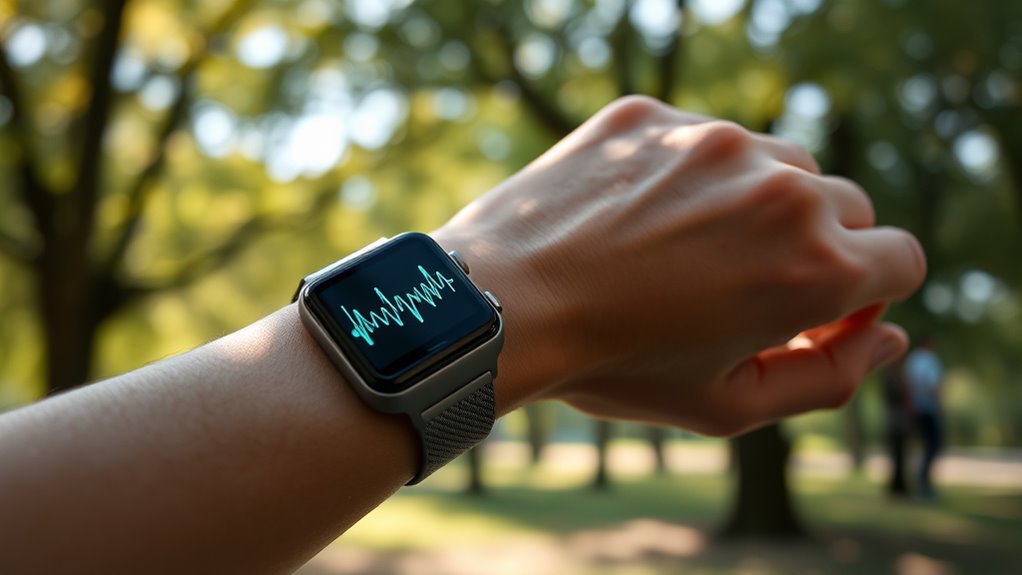
Stress can decrease your HRV, indicating your body is under strain. When you recover properly, your HRV tends to rise, showing your nervous system is balancing again. Understanding how stress and recovery influence HRV helps you optimize your health and performance. Incorporating wall organization systems can also promote a calming environment that supports better recovery and stress management. Additionally, engaging in activities that promote relaxation and mindfulness techniques can further enhance your body’s ability to recover effectively. Practicing diversification in your lifestyle choices, such as varied relaxation methods, can contribute to overall resilience and well-being. Implementing cybersecurity measures in your personal data can further safeguard your health information during recovery periods.
Stress Effects on HRV
Stress markedly influences heart rate variability (HRV), often causing it to decline as your body enters a state of heightened arousal. When you’re stressed, your nervous system shifts into fight-or-flight mode, reducing HRV levels. Chronic stress can suppress your body’s ability to recover, making it harder to restore balance. To counteract this, practices like mindfulness meditation can help lower stress and support higher HRV. Additionally, stress impacts sleep quality, which directly affects HRV; poor sleep diminishes your body’s resilience. Keep in mind:
- Elevated stress decreases HRV
- Mindfulness meditation promotes relaxation
- Poor sleep impairs HRV recovery
- Managing stress enhances overall heart health
- Recovery techniques help restore HRV balance
- Incorporating stress management strategies can further improve your HRV.
Recovery and HRV
Recovery plays a crucial role in restoring heart rate variability (HRV) after periods of stress. When you prioritize recovery, you help your body return to a state of heart coherence, which promotes balance between your sympathetic and parasympathetic nervous systems. Good sleep quality is essential during this process, as restful sleep enhances HRV and supports overall recovery. Activities like deep breathing, meditation, or gentle exercise can improve your HRV by reducing stress and encouraging heart coherence. By giving your body time to recover, you allow your nervous system to reset, leading to higher HRV levels over time. Consistent recovery practices not only improve your HRV but also boost resilience, helping you better handle future stressors.
Using HRV Data to Optimize Wellness and Performance

By monitoring your HRV data, you can gain real-time insights into your body’s readiness and adapt your wellness routines accordingly. HRV helps you identify patterns related to sleep quality and nutritional effects, enabling you to optimize recovery and performance. When your HRV is high, it indicates good recovery, better sleep, and effective nutrition. Conversely, low HRV signals stress, fatigue, or poor sleep, prompting adjustments. To maximize benefits, consider:
Monitoring HRV provides real-time insights to optimize recovery, sleep, nutrition, and training adjustments.
- Prioritizing restful sleep to boost HRV
- Adjusting nutrition to support recovery
- Incorporating relaxation techniques during low HRV periods
- Modifying training intensity based on HRV insights
- Tracking daily trends to refine your routines
Using HRV data empowers you to make informed choices, enhancing overall wellness and athletic performance.
Factors That Influence HRV Readings
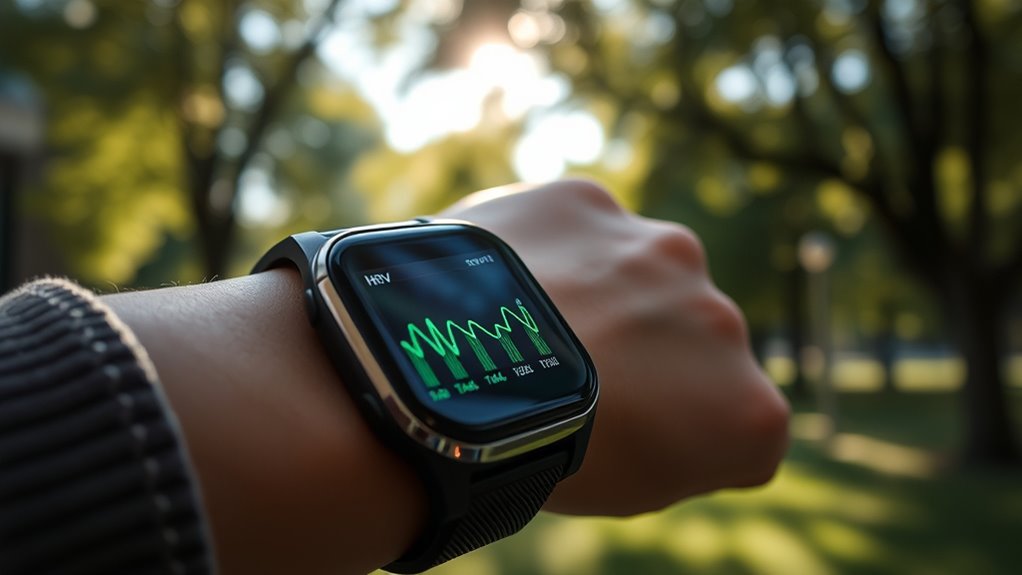
Several factors can directly influence your HRV readings, making it important to take into account your overall lifestyle. Hydration levels play a crucial role; dehydration can lower HRV, indicating stress or fatigue. Caffeine intake is another significant factor—consuming caffeine can temporarily increase heart rate and alter HRV patterns. Other influences include sleep quality, physical activity, and stress levels. Here’s a quick overview:
| Factor | Effect on HRV | Recommendations |
|---|---|---|
| Hydration levels | Low hydration reduces HRV | Stay well-hydrated throughout the day |
| Caffeine intake | Can cause temporary HRV changes | Limit caffeine before monitoring |
| Sleep quality | Poor sleep decreases HRV | Prioritize consistent, restful sleep |
Tips for Maximizing the Benefits of HRV Monitoring
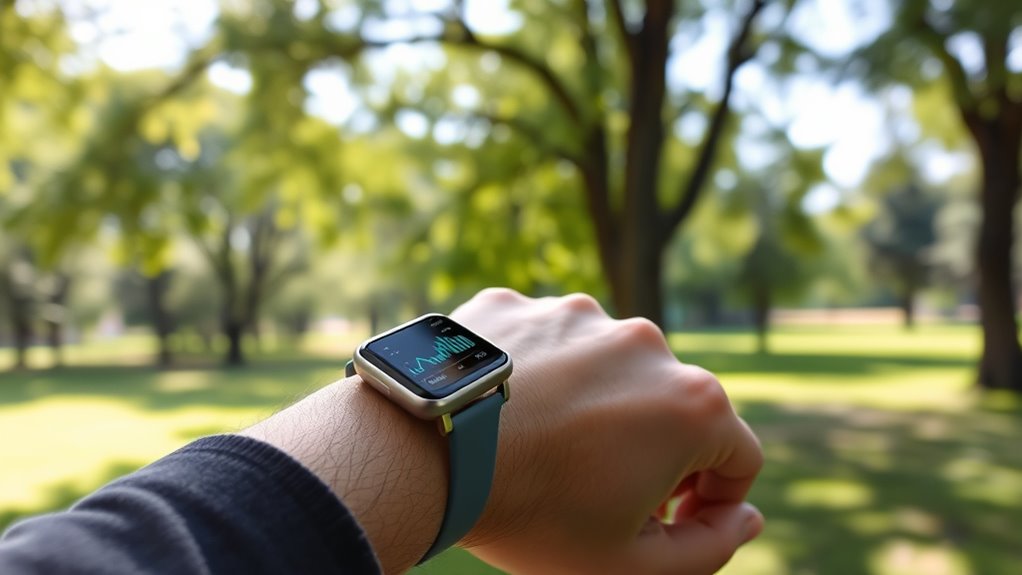
To maximize the benefits of HRV monitoring, it’s essential to establish consistent habits and interpret your readings carefully. Regularly practicing breathing techniques can help regulate your nervous system and improve HRV. Prioritize sleep quality, as restful sleep boosts HRV and overall recovery. Track your HRV over time to identify patterns and adjust your lifestyle accordingly. Avoid sudden changes in activity or stress, which can skew readings. Use your data to set realistic goals for stress management and recovery. Additionally, maintain good hydration and nutrition to support autonomic function. Consistency is key—monitor at the same time daily, especially during relaxed states. Remember, your HRV reflects your overall health, so integrating these habits enhances long-term benefits.
Frequently Asked Questions
Can HRV Predict Upcoming Health Issues Before Symptoms Appear?
You wonder if HRV can predict health issues before symptoms show up. While HRV data can be a valuable tool in predictive analytics, it’s not a crystal ball. HRV trends can signal early detection of stress or health problems, but they don’t guarantee a diagnosis. Use it as an early warning system, complementing regular check-ups, and consult healthcare professionals for an all-encompassing assessment.
How Does Hydration Affect HRV Readings?
Hydration impact can considerably influence your HRV readings. When you’re well-hydrated, fluid balance supports ideal heart function, often leading to higher HRV scores, indicating better resilience and recovery. Conversely, dehydration can lower HRV by stressing your body and impairing autonomic nervous system regulation. To get accurate HRV readings, make sure you’re properly hydrated, as fluid balance directly affects your body’s ability to maintain stability and respond to stress.
Is There an Ideal HRV Range for All Age Groups?
You might wonder if there’s an ideal HRV range for everyone, but age-specific norms vary widely. Your prime HRV range depends on your age, fitness level, and health. Younger individuals generally have higher HRV, while older adults may have lower numbers. Focus on tracking your own trends over time rather than comparing to a universal standard. Understanding your personal prime ranges helps you optimize your health and wellness.
Can Sleep Quality Improvements Boost HRV Overnight?
Improving your sleep quality can definitely boost your HRV overnight. Focus on good sleep hygiene by maintaining a consistent sleep schedule, avoiding screens before bed, and creating a relaxing environment. Managing stress through techniques like meditation or deep breathing also helps. When you prioritize both, your body recovers better, leading to higher HRV levels. Over time, these habits support your overall heart health and resilience.
How Do Different Exercise Types Influence HRV Patterns?
Different exercise types impact your HRV by influencing your movement patterns and recovery. Aerobic activities like running or cycling tend to boost HRV, showing improved autonomic balance. Strength training causes short-term drops but can enhance HRV over time with proper recovery. Flexibility exercises may stabilize HRV, promoting relaxation. Varying your workouts helps optimize your HRV patterns, supporting overall heart health and resilience, so mix different exercise types for balanced benefits.
Conclusion
Don’t let doubts hold you back—your HRV data is a powerful tool for understanding your body and improving your well-being. It’s natural to feel overwhelmed at first, but with consistent tracking, you’ll gain clearer insights into your stress, recovery, and overall health. Embrace this journey; your dedication can lead to better resilience, more energy, and a healthier life. Trust in your ability to make positive changes—your future self will thank you.









